Textile Fragment from the Dalmatic of San Valerius
This brocaded textile was originally applied to a dalmatic of Andalusian manufacture. It belongs to a collection of vestments attributed to the cult of Saint Valerius, who was the bishop of Saragossa, Spain, from 290 until 315. During the eleventh century his body was transferred to the Cathedral of San Vicente de Roda de Isábena in in Huesca (Aragon) from where relics were dispatched to other churches. The textiles were made to venerate the saint, with the dalmatic worn on the occasion of his feast day.
Artwork Details
- Title:Textile Fragment from the Dalmatic of San Valerius
- Date:13th century
- Geography:Attributed to Spain
- Medium:Silk, gilt animal substrate around a silk core; lampas with seperable layers in the ground weave
- Dimensions:Textile:
H. 3 in. (7.6 cm)
W. 4 3/4 in. (12.1 cm)
Mount:
H. 6 5/8 in. (16.8 cm)
W. 8 7/8 in. (22.5 cm)
D. 1 1/4 in. (3.2 cm) - Classification:Textiles
- Credit Line:Fletcher Fund, 1946
- Object Number:46.156.4
- Curatorial Department: Islamic Art
More Artwork
Research Resources
The Met provides unparalleled resources for research and welcomes an international community of students and scholars. The Met's Open Access API is where creators and researchers can connect to the The Met collection. Open Access data and public domain images are available for unrestricted commercial and noncommercial use without permission or fee.
To request images under copyright and other restrictions, please use this Image Request form.
Feedback
We continue to research and examine historical and cultural context for objects in The Met collection. If you have comments or questions about this object record, please contact us using the form below. The Museum looks forward to receiving your comments.
